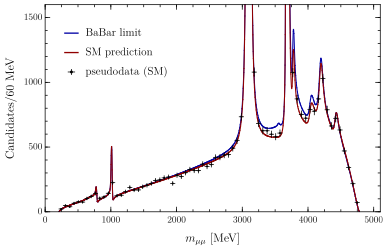Rare decays
Rare decays of beauty hadrons constitute an ideal laboratory for the search for physics phenomena beyond the Standard Model (SM). These decays are Flavour Changing Neutral Currents (FCNC) and are thus forbidden at tree level in the SM. Rare, loop-mediated processes allow indirect access to quantum corrections from degrees of freedom at larger scales and provide excellent complementarity to direct searches of New Physics (NP).
Our group is one of the main players in the study of b→sll processes, mainly focused on two aspects: the study of the angular distribution of B0→K*0μμ decays, and the test of lepton flavour universality in B0→K*0ll decays. The main feature of these two types of analysis is that the results so far are showing tensions with the SM predictions, providing tantalizing hints of NP phenomena: on one hand, the analysis of the angular distribution of the B0→K*0μμ with LHCb Run I data shows a deviation of 3.4σ with respect to the SM prediction, and, on the other, the study of the branching fractions of B+→K+μμ, B0→K*0μμ and B0→phiμμ decays show deviations of 2-4σ with respect to the expected value.

- Figure 1. Measurements of P5′ performed by LHCb using datas (black), compared to the SM theoretical predictions (orange).
Our group led the effort in measuring the angular distribution of the B0→K*0μμ with LHCb Run I and is currently working on disentangling QCD from new physics by fitting the decay distribution unbinned in q2. This can also have sensitivity to virtual contributions from tau-lepton decays, which connects these discrepancies with the semileptonic anomalies as can be seen in Fig. 2. Additionally, work is ongoing to study lepton flavour universality in the angular distributions of B0→K*0μμ and B0→K*0ee decays.
Figure 2. q2 distribution of B+→K+μμ decays with and without an enhanced contribution from virtual B+→K+tautau decays.
In addition to these activities, our group has been involved in the search for long-lived scalar particles, which provide access to many different hidden sector models, and lepton flavour violation in tau decays, using data from Run I in both cases. Moreover, we are currently involved in the study of radiative decays of beauty hadrons, which can be used to constrain NP models with large right-handed currents.

![[New Group Photo from Virtual retreat 2021]](/dam/jcr:da62b570-f5e7-4efe-bde8-d81d50e4d137/virtual_photo.png)